Troubleshoot Radio Shack Multimeter 22-163 Not Reading Ac Voltage
If your introduction to digital electronics came more years agone than you'd care to mention, the chances are you did and then with 5V TTL logic. Above 2V but usually pretty close to 5V is a logic one, beneath 0.8V is a logic 0. If y'all were a dandy reader of electronic text books you might have read about dissimilar voltage levels tolerated by 4000 serial CMOS gates, but the chances are even with them you'd have still used the familiar 5 volts.
This happy state of never encountering anything just 5V logic equally a hobbyist has not persisted. In recent decades the demands of higher speed and lower ability have given u.s. successive families of lower voltage devices, and we volition now usually also meet 3.3V or even sometimes lower voltage devices. When these different families need to coexist equally for example when interfacing to the current crop of microcontroller boards, intendance has to be taken to avoid impairment to your silicon. Some ways of managing the transition between voltages is required, then we're going to take a look at the world of level shifters, the circuits we apply when interfacing these different voltage logic families.
Practice You Even Demand A Level Shifter?
It might seem odd to start a treatise on level shifting this way, simply the first question for the designer when looking at making a 3.3V part talk to a 5V function should be this: Do I even need a level shifter?
If the 3.3V part is an output and the 5V 1 an input, the lower voltage part tin hardly impairment the higher voltage one with overvoltage. And yous are not likely to encounter a logic input that might demand then much current that it would impairment your output (If you exercise, use a buffer!). If yous are lucky the logic voltage ranges of the two devices may fifty-fifty coincide. For example 3.3V TTL logic shares the 0.8V and 2V thresholds for logic 0 and logic 1 transitions with 5V TTL logic, so a iii.3V TTL output can drive a 5V TTL input without whatever extra hardware required.
In the other management, driving a 3.3V input from a 5V output you lot might expect that a level shifting circuit would be required, and in many cases you would be correct. Merely earlier reaching for that shifter it's worth taking a await at the detailed specifications of your 3.3V input. Many devices are designed to be 5V tolerant, and you might be lucky enough to find that your excursion could use one and avoid the actress circuitry. For example the 74LVC series contains a range of 5V tolerant three.3V versions of many 74-series ICs.
CMOS And TTL: A Level Shifting Cautionary Tale
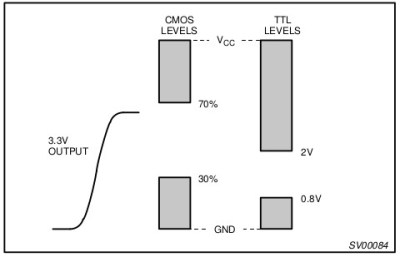
When direct driving logic you'd commonly use at 5V from a 3.3V output at that place is one cautionary tale of which to accept heed, a personal confession of an electronic failure. CMOS logic defines its logic thresholds as a per centum of supply voltage, which with a 5V supply puts the logic i threshold of seventy% well above the three.3V logic i. Some CMOS ICs such equally the 74HC4053 counterpart switch I used in a Raspberry Pi project don't quite follow this standard and will piece of work from a 3.3V TTL output, so I was lulled into a false sense of security and reached for another 74HC part to connect to my Raspberry Pi with a new design. As you might expect information technology failed to work, and of class I wasted fourth dimension looking everywhere else but my defective choice of part. If there is a moral to this story it is to e'er read the datasheet carefully, and use the TTL-compatible parts such as in this case 74HCT, when they are available.
If your 3.3V device inputs are not 5V tolerant and your 5V inputs lack 3.3V compatible thresholds then sadly yous won't exist able to interface them across voltage levels without a shifter circuit. There are many choices available to yous including a whole host of dedicated level shifter devices such as these ones from TI, just aside from personal preference some of them will be dictated past your awarding. Volition it be a stride-up, a step-down, or do you need a bi-directional level shifter? If you decide non to apply a dedicated part or a 5V tolerant gate in your design, here are a few of the many alternatives.
Step-down level shifters
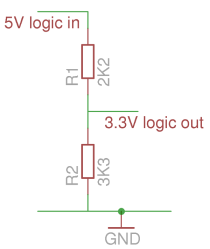
The simplest possible step-down circuit is a resistive divider. Bulldoze your 5V output into a chain of resistors, from which yous tap your 3.3V logic input. A chain consisting of a 2.2k and a 3.3k resistor should produce a 3V output from an practical 5V input. It does not preserve the fan-out characteristic of the 3.3V output and you need to be aware of any capacitances that may likewise reside in whatever logic is connected to information technology and the effect they may have forth with the resistors on fast rise times, but it should suffice for most elementary level downshifting tasks facing a hobbyist. There are variations on this excursion that utilize diodes instead of a resistor to achieve the required voltage drop.
If the divider is not suitable for your awarding and you still eschew a dedicated shifter, take a expect further down the page at bidirectional shifters.
Footstep-upwardly level shifters
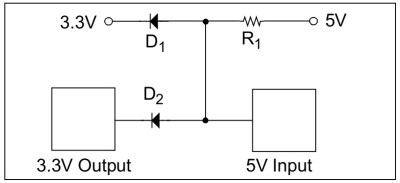
For stepping up from 3.3V logic to 5V logic and assuming you are not safely within the TTL thresholds as described to a higher place such that you can do without a shifter, you will crave something a little more complex than the resistive divider in the previous section. The simplest circuit uses a pair of diodes with careful biasing and choice of series resistor as shown in the diagram to the right. The application annotation it comes from advises that the resistor should be significantly less than the input impedance of the 5V gate, to avert its being part of a resistive divider with that impedance having an issue on the output voltage.
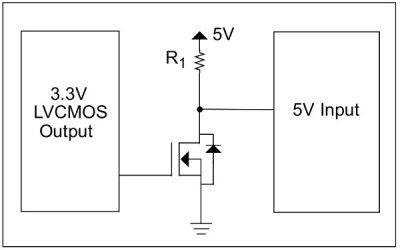
A rather more obvious circuit uses a MOSFET or bipolar transistor as a switch, driving the gate or base with the iii.3V logic and taking the 5V logic output from the bleed or collector. This is very similar to using a gate with an open-collector output in the same awarding. This is a simple and reliable circuit, but information technology must be borne in mind that it inverts the 3.3V logic level.
Bi-directional level shifters
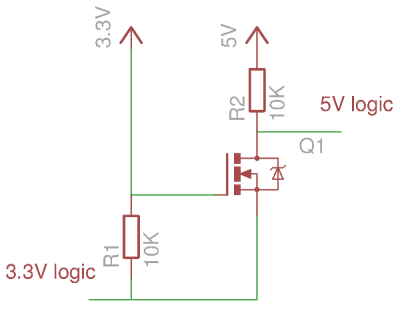
The circuits in the previous two sections are both just suitable for unidirectional logic lines, but not in the example of a bidirectional omnibus. Every bit earlier at that place are plenty of off-the-shelf bus level shifters from a range of semiconductor manufacturers to choose from, just if these are not suitable for your blueprint and so a handy alternative can be made with a MOSFET and a couple of resistors. It'south also worth pointing out that this doesn't have to be used on a bidirectional bus, it tin serve as a general purpose level shifter for the cost of a 2N7000 or similar, indeed this is a personal favourite for this application. Y'all can readily buy this circuit on a breakout board from several electronics suppliers if building information technology yourself doesn't entreatment. For more than information on its performance take a read of the Philips awarding note AN97055 (PDF), which examines its use on an I2C charabanc.
Information technology can exist a worry, when you starting time have to ensure that different logic levels are safely interfaced. Volition my 5V Arduino impairment this 3.3V sensor? We hope that after reading this piece you'll have some more conviction, and we've equipped you lot with enough to make some sense of the topic. We've not covered every possible technique, simply if you read some of the attached application notes and then search the spider web for real-world usage they should make full in whatever gaps.
Source: https://hackaday.com/2016/12/05/taking-it-to-another-level-making-3-3v-and-5v-logic-communicate-with-level-shifters/
Post a Comment for "Troubleshoot Radio Shack Multimeter 22-163 Not Reading Ac Voltage"